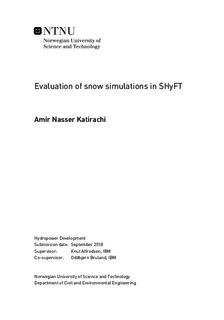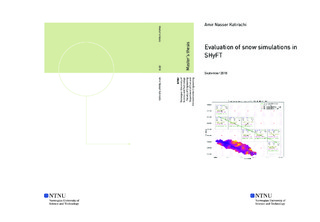| dc.description.abstract | The main objective of this paper is to evaluate the SHyFT snow routine performance against observed snow data obtained from snow measurements in the field. SHyFT (Statkraft Hydrological Forecasting Toolbox) is an open source hydrological model recently developed by Statkraft for forecasting inflow. The system of the model has been designed in a flexible manner to allow ease of customization for various purposes. The SHyFT toolbox currently has three different methods for simulating snow accumulation and snow depletion, which have not previously been evaluated with snow data. These methods are Gamma snow distribution routine, HBV snow routine and Skaugen snow routines. Each method has its own parameters and unique approach to model the snow accumulation and snow melt.
The case study is based on 2876 km² area of the Nea-Nidelva catchment which is located in the center of Norway (63° N, 10° E). A grid scale of 1 km is used, dividing the catchment into 3606 cells with some of the cells, located around the edges, being less than 1km².
Simulated results of SWE (Snow Water Equivalent) based on the three previously mentioned methods using data from 2012 to 2017 were compared against observed SWE from snow course data. The snow course data, provided by Statkraft, has 6 snow courses in a period of 5 years. The SWE data were recorded using a snow radar which collected it per meter, on average. Each snow course transect passes some cells so that these cells contain observed data points.
200 calibrations were conducted for each method, out of which the best 36 results were selected. An average of these was computed and used as a representative of the associated method. Simulations with the calibrated data were conducted and the results analyzed and discussed. The analysis was based on correlation of specific parameters; slope, elevation, terrain roughness and number of observed points in a cell against the absolute error of SWE, of which a discussion is provided. Further, in addition the Pearson correlation coefficient were presented for each scatter plot and the three methods. The hydrographs, SCA (Snow Cover Area) and SWE graphs were examined to observe similarities and dissimilarities of the different methods. The results of PTGSK (Priestley Taylor Gamma Snow Kirchner) show a variation in SCA as well as in SWE when compared with PTSSK (Priestley Taylor Skaugen Snow Kirchner) and PTHSK (Priestley Taylor HBV Snow Kirchner). Further, the comparison of satellite images with SCA images provides a good basis for identifying the method that generates a better simulation. | |

